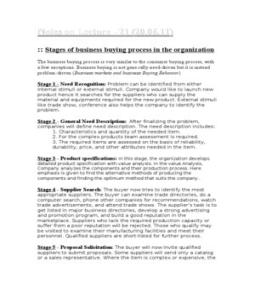scribd. scribd. scribd. scribd. scribd. scribd. scribd. scribd.
Notes on Lecture - 21 (20.06.11)Notes on Lecture - 21 (20.06.11)
::
Stages of business buying process in the organization
The business buying process is very similar to the consumer buying process, witha few exceptions. Business buying is not gene rally need-driven but it is instead problem-driven (
Business markets and business Buying Behavior
).
Stage 1 - Need Recognition:
Problem can be identified from eitherinternal stimuli or external stimuli. Company would like to launch newproduct hence it searches for the suppliers who can supply thematerial and equipments required for the new product.
External stimulilike trade show, conference also helps the company to identify theproblem.
Stage 2 - General Need Description:
After finalizing the problem,companies will define need description. The need description includes:1. Characteristics and quantity of the needed item.2. For the complex products team assessment is required.3. The required items are assessed on the basis of reliability,durability, price, and other attributes needed in the item.
Stage 3 - Product specifications:
In this stage, the organization developsdetailed product specification with value analysis. In the value Analysis,Company analyzes the components and their production process. Hereemphasis is given to find the alternative methods of producing thecomponents and finding the optimum method that suits the company.
.
Stage 4 - Supplier Search
:
The buyer now tries to identify the mostappropriate suppliers. The buyer can examine trade directories, do acomputer search, phone other companies for recommendations, watchtrade advertisements, and attend trade shows. The supplier’s task is toget listed in major business directories, develop a strong advertisingand promotion program, and build a good reputation in themarketplace. Suppliers who lack the required production capacity orsuffer from a poor reputation will be rejected. Those who qualify maybe visited to examine their manufacturing facilities and meet theirpersonnel. Qualified suppliers are short-listed for further process.
Stage 5 - Proposal Solicitation
:
The buyer will now invite qualifiedsuppliers to submit proposals. Some suppliers will send only a catalogor a sales representative. Where the item is complex or expensive, the








buyer requires a detailed written proposal from each qualified supplier. The buyer will invite qualified suppliers to make formal presentations. Thus business marketers must be skilled in researching, writing andpresenting proposals. Their proposals should be marketing documents,not just technical documents. Their oral presentations should inspireconfidence. They should position their company’s capabilities andresources so that they stand but from the competition
.
Stage 6 - Supplier selection:
This stage is also known as vendorselection. During this stage companies will prepare the checklist.Weight ages are assigned against each checklist point and evaluated.Some of the important attributes those commonly found in the vendorevaluations are:a. Qualityb. Deliveryc. Communicationd. Competitive prices.e. Servicingf. Technical adviceg. Performance historyh. Reputation
Stage 7 - Order Routine specifications:
The buyer now negotiates thefinal order with the chosen supplier(s), listing the technicalspecifications; the quantity needed, the expected time of delivery,return policies, warranties and so on. In case of MRO items(Maintenance, Repair and Operating items), buyers are increasinglymoving towards blanket contracts rather than periodic purchaseorders. Writing a new purchase order each time stock is needed, isexpensive. Nor does the buyer want to write fewer and larger purchaseorders because that means carrying more inventories. A blanketcontract establishes a long-term relationship where the supplierpromises to re-supply the buyer as needed on agreed price terms overa specified period of time. The stock is held by the seller, hence thename stockless purchase plan. The buyer’s computer automaticallysends an order to the seller when stock is needed. This locks thesupplier with the buyer and makes it difficult for out-suppliers to breakin unless the buyer becomes dissatisfied with the in-suppliers prices,quality or service.
Stage 8 - Performance review:
In this stage, the organization review theperformance of the suppliers. This will help it to decide whether tocontinue with existing suppliers or should search for the new vendor.



:: Buying Situations in The Industrial Marketing.
Buying situations varies to the large extent in the industrial marketingcompared to the consumer markets. The negotiation process andvendor evaluation stages will not be there if company wants topurchase the same material from the existing suppliers. It means foreach situations buying process changes. Therefore in this section weare discussing the different situation involved in the business buying.Industrial marketing usually involves three different types of buyingsituations. They are the followings:
1. New task:
A purchaser buys a product or service for the first time (e.g., officebuilding, new security system). The greater the cost or risk, the larger the number of participants and the greater their information gathering—and therefore thelonger the time to a decision.
2. Straight rebuy:
The purchasing department reorders on a routine basis (e.g.,office supplies, bulk chemicals) and chooses from suppliers on an "approvedlist." The suppliers make an effort to maintain product and service quality andoften propose automatic reordering systems to save time. "Out-suppliers"attempt to offer something new or to exploit dissatisfaction with a currentsupplier. Out-suppliers try to get a small order and then enlarge their purchaseshare over time.
3. Modified rebuy:
The buyer wants to modify product specifications, prices,delivery requirements, or other terms. The modified rebuy usually involvesadditional participants on both sides. The in-suppliers become nervous and haveto protect the account. The out-suppliers see an opportunity to propose a belter offer to gain some business.
:: Participants in the Business Buying Process
1. Initiators:
Those who request that something be purchased. They may beusers or others in the organization.
2. Users:
Those who will use the product or service. In many cases, theusers initiate the buying proposal and help define the product requirements.
3. Influencers:
People who influence the buying decision. They often helpdefine specifications and also provide information for evaluatingalternatives. Technical personnel are particularly important influencers.
4. Deciders:
People who decide on product requirements or on suppliers.
5. Approvers:
People who authorize the proposed actions of deciders or buyers.
6. Buyers:
People who have formal authority to select the supplier andarrange the purchase terms. Buyers may help shape product specifications,


Search History:
Result 00 of 00
00 results for result for
p.
Comments
Load more


















